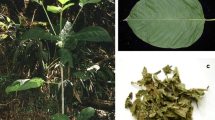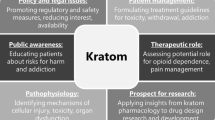Abstract
Purpose of Review
Kratom (Mitragyna speciosa) is an herb with no current indication for medical use with potentially addictive properties, yet it is being used in the management of pain, depression, and anxiety. The agent’s pharmacology lends itself for concern regarding recreational misuse (Drugs of Abuse, 2017).
Recent Findings
Kratom’s increasing popularity for use in the USA is reflected by National Poison Data System data that in 2011 there were 13 cases reported to poison control centers while in 2017 there were 682 calls in response to kratom exposure (Kratom exposure in the US linked to serious medical outcomes, 2019; Post et al. in Clin Toxicol. 57:847–54, 2019). Subjects most commonly use kratom for the self-treatment of pain, mood swings, and opioid-related withdrawal symptoms (Grundmann in Drug Alcohol Depend. 176:63–70, 2017). Known serious adverse events include hallucinations, delusions, reduced respiratory drive, and death (Kratom: unsafe and ineffective, 2019). Additional anecdotally reported side effects include hypothyroidism, seizure, hepatotoxicity, coma, and injury to the posterior white matter of the brain (Anwar et al. in MMWR Morb Mortal Wkly Rep. 65:748–9, 2016; Nelsen et al. in J Med Toxicol. 6:424–6, 2010; Sheleg and Collins in J Addict Med. 5:300–1, 2011; Castillo et al. in Proc (Baylor Univ Med Cent). 30:355–7, 2017).
Summary
At this time, kratom remains without regulations on a federal level. The substance’s opioid-like pharmacology, ease of use, and lack of demonstrated safety or efficacy justify the need for continued extensive research (Brooks, 2019).


Similar content being viewed by others
References
Papers of particular interest, published recently, have been highlighted as: • Of importance
Drugs of Abuse. A DEA Resource Guide and DEA Announces Intent to Schedule Kratom. dea.gov. Updated 2017. Accessed February 12, 2019. Available at: https://www.dea.gov/press-releases/2016/08/30/dea-announces-intent-schedule-kratom.
Kratom exposure in the US linked to serious medical outcomes. empr.com. Published February 21, 2019. Accessed February 21, 2019. Available at: https://www.empr.com/home/news/kratom-exposure-in-the-us-linked-to-serious-medical-outcomes/.
• Post S, Spiller H, Chounthirath T, Smith G. Kratom exposures reported to United States poison control centers: 2011–2017. Clin Toxicol. 2019;57:847–54 Available at: https://www.tandfonline.com/doi/full/10.1080/15563650.2019.1569236?af=R. This reference was important for providing significant context for kratom being a substance for misuse.
American Kratom Association. Kratom legality map. Accessed March 9, 2019. Available at: http://speciosa.org/home/kratom-legality-map/.
Anwar M, Law R, Schier J. Notes from the field: kratom (mitragyna speciosa) exposures reported to poison centers — United States, 2010–2015. MMWR Morb Mortal Wkly Rep. 2016;65:748–9 Available at: https://www.cdc.gov/mmwr/volumes/65/wr/mm6529a4.htm.
Boyer EW, Babu KM, Adkins JE, McCurdy CR, Halpern JH. Self-treatment of opioid withdrawal using kratom (Mitragynia speciosa korth). Addiction. 2008;103(6):1048–50 Available at: https://www.ncbi.nlm.nih.gov/pmc/articles/PMC3670991/.
• Grundmann O. Patterns of kratom use and health impact in the united states- results from an online survey. Drug Alcohol Depend. 2017;176:63–70. https://doi.org/10.1016/j.drugalcdep.2017.03.007 Accessed February 13, 2019. Available at: https://www.sciencedirect.com/science/article/pii/S0376871617301825?via%3Dihub. This reference was important for providing significant context for kratom being a substance for misuse.
Kratom: unsafe and ineffective. mayoclinic.org. Updated February 23, 2019. Accessed February 25, 2019. Available at: https://www.mayoclinic.org/healthy-lifestyle/consumer-health/in-depth/kratom/art-20402171.
Nelsen JL, Lapoint J, Hodgman MJ, Aldous KM. Seizure and coma following Kratom (Mitragynina speciosa Korth) exposure. J Med Toxicol. 2010;6(4):424–6 Available at: https://www.ncbi.nlm.nih.gov/pmc/articles/PMC3550469/.
Sheleg SV, Collins GB. A coincidence of addiction to “Kratom” and severe primary hypothyroidism. J Addict Med. 2011;5(4):300–1 Available at: https://www.ncbi.nlm.nih.gov/pubmed/21817918.
Castillo A, Payne JD, Nugent K. Posterior reversible leukoencephalopathy syndrome after kratom ingestion. Proc (Baylor Univ Med Cent). 2017;30(3):355–7 Available at: https://www.ncbi.nlm.nih.gov/pubmed/28670086.
Hughes RL. Fatal combination of mitragynine and quetiapine - a case report with discussion of a potential herb-drug interaction. Forensic Sci Med Pathol. 2019;15(1):110–3 Available at: https://link.springer.com/article/10.1007%2Fs12024-018-0049-9.
Aggarwal G, Robertson E, McKinlay J, Walter E. Death from kratom toxicity and the possible role of intralipid. J Intensive Care Soc. 2017;19(1):61–3 Available at: https://www.ncbi.nlm.nih.gov/pmc/articles/PMC5810870/.
McIntyre I, Trochta A, Stolberg S, Campman S. Mitragynine ‘Kratom’ related fatality: a case report with postmortem concentrations. J Anal Toxicol. 2015;39(2):152–5 Available at: https://academic.oup.com/jat/article/39/2/152/763622.
Neerman M, Frost R, Deking J. A drug fatality involving kratom. J Forensic Sci. 2013;58(1):S278–9 Available at: https://onlinelibrary.wiley.com/doi/abs/10.1111/1556-4029.12009.
Riverso M, Chang M, Soldevila-Pico C, Lai J, Liu X. Histologic characterization of kratom use-associated liver injury. Gastroenterol Res. 2018;11(1):79–82 Available at: https://www.ncbi.nlm.nih.gov/pmc/articles/PMC5827910/.
Kapp FG, Maurer HH, Auwarter V, Winkelmann M, Hermanns-Clausen M. Intrahepatic cholestasis following abuse of powdered kratom (Mitragyna speciosa). J Med Toxicol. 2011;7:227–31 Available at: https://www.ncbi.nlm.nih.gov/pmc/articles/PMC3550198/.
Dorman C, Wong M, Khan A. Cholestatic hepatitis from prolonged kratom use: a case report. Hepatology. 2015;61:1086–7 Available at: https://aasldpubs.onlinelibrary.wiley.com/doi/full/10.1002/hep.27612.
Pizarro-Osilla C. Introducing…Kratom. J Emerg Nurs. 2017;43(6):504 Available at: https://www.sciencedirect.com/science/article/pii/S0099176717301423?via%3Dihub.
Galbis-Reig D. A case report of kratom addiction and withdrawal. WMJ. 2016; Accessed February 20, 2019. Available at: http://www.wisconsinmedicalsociety.org/_WMS/publications/wmj/pdf/115/1/49.pdf.
Phillip AL. Heroin abstinence: a case report of kratom in the emergency department and beyond. West J Emerg Med. 2019;20:2 Available at: https://escholarship.org/uc/item/631314rk.
Tatum WO, Hasan TF, Coonan EE, Smelick CP. Recurrent seizures from chronic kratom use, an atypical herbal opioid. Epilepsy Behav Case Rep. 2018;10:18–20 Available at: https://www.ncbi.nlm.nih.gov/pmc/articles/PMC6063981/.
LaBryer L, Sharma R, Chaudhari KS, Talsania M, Scofield RH. Kratom, an emerging drug of abuse, raises prolactin and causes secondary hypogonadism: case report. J Investig Med. 2018;6:1–3 Available at: https://www.ncbi.nlm.nih.gov/pmc/articles/PMC5858613/.
Castillo A, Payne JD, Nugent K. Posterior reversible leukoencephalopathy syndrome after kratom injection. Proc (Bayl Univ Med Cent). 2017;30(3):355–7 Available at: https://www.ncbi.nlm.nih.gov/pmc/articles/PMC5468044/.
FDA and Kratom. fda.gov. Updated February 15, 2019. Accessed February 20, 2019. Available at: https://www.fda.gov/newsevents/publichealthfocus/ucm584952.htm.
• Statement from FDA Commissioner Scott Gottlieb, M.D., On the agency’s scientific evidence on the presence of opioid compounds in kratom, underscoring its potential for abuse. fda.gov. published February 6, 2018. Accessed February 12, 2019. Available at: https://www.fda.gov/newsevents/newsroom/pressannouncements/ucm595622.htm. This reference was important for providing significant context for kratom being a substance for misuse.
FDA Oversees Destruction and Recall of Kratom Products; and Reiterates its Concerns on Risks Associated with this Opioid. fda.gov. Published February 21, 2018. Accessed February 15, 2019. Available at: https://www.fda.gov/newsevents/newsroom/pressannouncements/ucm597649.htm.
Withdrawal of notice of intent to temporarily place mitragynine and 7-hydroxymitragynine into schedule I. federalregister.gov. Published October 13,2016. Accessed February 12, 2019. Available at: https://www.federalregister.gov/documents/2016/10/13/2016-24659/withdrawal-of-notice-of-intent-to-temporarily-place-mitragynine-and-7-hydroxymitragynine-into.
Brooks M. FDA warns more kratom makers over illegal sales, false claims. Medscape. Published June 25, 2019. Accessed July 9, 2019. Available at: https://www.medscape.com/viewarticle/914866?nlid=130353_3901&src=wnl_newsalrt_190625_MSCPEDIT&uac=52426DX&impID=2007306&faf=1.
FDA in Brief. FDA objects to kratom compound intended for use as an alternative to prescription opioids and promoted with unproven claims to treat addiction. fda.gov. Published February 26, 2018. Accessed February 20, 20. Available at: https://www.fda.gov/NewsEvents/Newsroom/FDAInBrief/ucm598389.htm.
Acknowledgments
The authors wish to thank Dr. Glee Lenoir for reviewing their manuscript.
Author information
Authors and Affiliations
Corresponding author
Ethics declarations
Conflict of Interest
The authors declare that they have no conflict of interest.
Human and Animal Rights and Informed Consent
This article does not contain any studies with human or animal subjects performed by any of the authors.
Additional information
Publisher’s Note
Springer Nature remains neutral with regard to jurisdictional claims in published maps and institutional affiliations.
This article is part of the Topical Collection on Pharmacology Care
Rights and permissions
About this article
Cite this article
Colucci, S., Culbreth, S., Alsarraf, E. et al. Why Does the Food and Drug Administration Need to Ban Kratom?. Curr Emerg Hosp Med Rep 7, 169–174 (2019). https://doi.org/10.1007/s40138-019-00201-5
Published:
Issue Date:
DOI: https://doi.org/10.1007/s40138-019-00201-5




